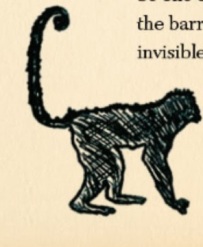
I have been working with Mystimus “digging” deeper in Ship of Theseus to find new clues to the themes that are hiding in plain sight. His post on Birds of Negative Space made me begin to take a longer look at what I like to call the “margin conversation.” It has been interesting what I have noticed. One such find was a note on page 220 by Eric that read, “REALLY WISH WE HAD THAT PHOTO…” This led to a close examination of the Havana photos and some discoveries about which Mystimus recently blogged. Francisco Carvalho @uriaalge who authors the blog, http://searchingsbook.blogspot.pt/ found more evidence on the Havana photos which he commented about on Mystimus’ blog post. This collaboration-readers working together- is very similar to Eric and Jen. There are others, believe me, which you will be reading about in the coming weeks as Mystimus and I prove and refine them.
This adventure back through Eric and Jen’s conversation has given me a new perspective on the two characters. On page xi of the forward, Jen asks if she should read Painted Cave which Eric had underlined in pencil. Eric replies, “NO,. GO BACK TO BRAXENHOLM (THE FIRST) AND WORK CHRONOLOGICALLY.” Then on Pg. xiv Jen writes, “This phrase is in Coriolis(p.464). And in Winged Shoes(p. 268). Eric replies, “HOW HAVE YOU HAD TIME TO READ ALL OF THIS?” Jen says, “Recently dumped, senoritis, etc.” Eric then says, “YOU’RE NOT READING THEM IN ORDER.” Jen then retorts, “Never been much for following directions.”
These interactions between the two characters are very telling. Eric has a concrete sequential personality type. He is all about reading novels from first to last and beginning to end. For Eric, it is impossible to think about reading VMS novels out of order.
On the other hand there is Jen. She has an abstract-random personality type. To read the novels out of order is not a big deal to her. She makes connections and brings them to light in the margins.
These two characters work brilliantly together. Eric teaches her in the margins to think in a sequential manner to find stability when she gets panicked. Jen teaches Eric through the margins to be spontaneous and think out of the box. It is her randomness that has discovered the answers to the ciphers. Remember, Ship of Theseus had been in the hands and mind of Eric since high school (14-15 years)[pg. vi], yet with Jen’s assistance, Eric has a better understanding of VMS/FXC and the story contained within the pages of Ship of Theseus. Together, they share that story with us within their conversations in the margins-the negative space. As Mystimus wrote,
“The story of Ship of Theseus and the story told by Eric and Jen in the marginalia seems at first glance to be tragically incomplete. We seem to be left with so many unanswered questions. But we are not – all the answers we seek are there in front of us. We just have to shift our focus onto the negative space.”
Take a deeper look at the margin conversation. Work with Mystimus and I or find another S fan to “dig” deeper together…You will be surprised by what you might have missed!


 On page 352 of S, Anca tells S to “Follow the monkey.” Jen Heyward circles the phrase and adds a comment, “Sound advice.” I believe this ‘sound advice’ can be followed through many, if not all of the works of JJ Abrams.
On page 352 of S, Anca tells S to “Follow the monkey.” Jen Heyward circles the phrase and adds a comment, “Sound advice.” I believe this ‘sound advice’ can be followed through many, if not all of the works of JJ Abrams.







